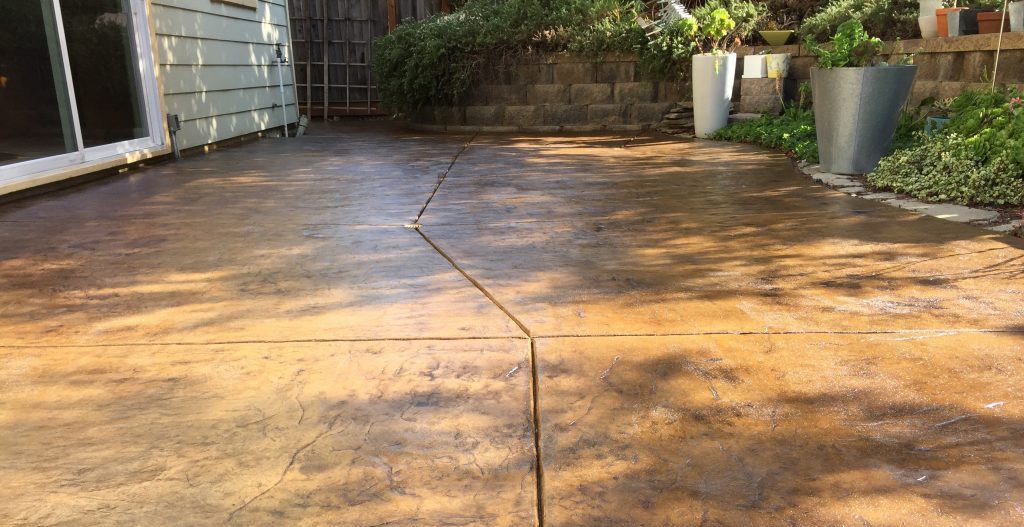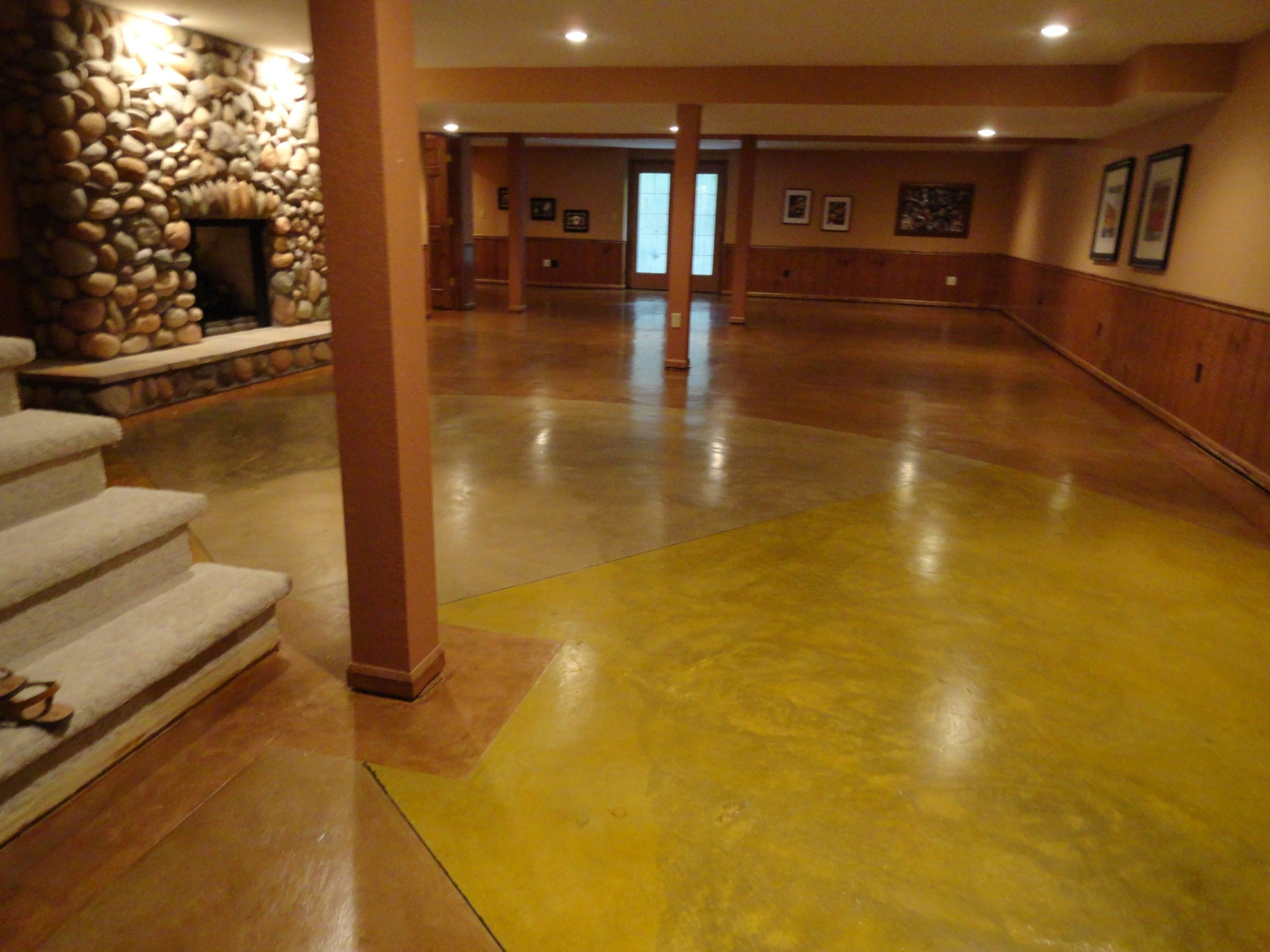How to select the right stained concrete company for your home renovation
Wiki Article
Comprehending the Various Sorts Of Stained Concrete for Your Following Task
Stained concrete offers different options that deal with various visual and functional needs. Each kind offers unique characteristics that affect the last appearance and sturdiness of the surface area. Understanding these differences is essential for any person intending a task. From rich, chain reactions of acid-based stains to the vivid harmony of solid shade stains, the selections can significantly influence the end result. What aspects should one think about when choosing the excellent discolor for their specific needs?Summary of Stained Concrete
Stained concrete functions as a functional flooring alternative that can improve the visual charm of various areas. This strategy involves using a coloring agent to the surface of existing concrete, enabling a broad spectrum of design opportunities. Stained concrete is prominent in both residential and commercial settings, offering a sturdy and low-maintenance service that can resemble the appearance of all-natural materials like rock or tile.The staining process can be performed utilizing water-based or solvent-based products, each offering distinct visual results. The final appearance is affected by factors such as the original concrete surface area, the type of discolor made use of, and the application technique. Stained concrete not just improves interiors and exteriors yet likewise promotes sustainability by renewing existing concrete structures. Therefore, it has actually gained traction among home owners and developers seeking both performance and design in their floor covering selections.
Acid-Based Stains: Features and Advantages

Unique Color Variants
Concrete surfaces can transform dramatically with the application of acid-based stains, which use an abundant palette of distinct color variations. These stains penetrate the concrete, reacting chemically to produce vibrant earth tones that vary from deep browns and reds to soft greens and blues. The resulting colors are frequently variegated, developing an all-natural, marble-like look that improves the concrete's personality. Each application returns distinctive outcomes as a result of variants in the concrete's make-up and the discoloration method utilized, making every task one-of-a-kind. In addition, acid-based stains can be split or integrated with other techniques to create customized layouts, enabling personal expression. This adaptability makes acid-based stains a preferred selection for both domestic and business applications.Chain Reaction Discussed
While numerous aspects add to the performance of acid-based stains, the underlying chemical reactions play a vital role in their one-of-a-kind attributes and benefits. These stains primarily include water, acid, and metal salts. When put on concrete, the acid responds with the calcium hydroxide in the cement, creating a chemical improvement that leads to long-term color modifications. The metallic salts penetrate the surface area and bond with the concrete, permitting for a large range of shades and tones. This reaction not only boosts aesthetic appeal however additionally provides toughness, making the color resistant to fading and wear. Additionally, acid-based stains can create a variegated coating that imitates all-natural stone, more enhancing their popularity for attractive concrete applications.Surface Area Prep Work Significance
Achieving excellent results with acid-based stains depends upon complete surface prep work. This necessary step warranties that the concrete surface area is clean, complimentary of pollutants, and effectively profiled for optimal discolor absorption. Any type of existing sealants, dirt, or oils can prevent the chemical response that produces the preferred shade and coating, causing uneven or irregular results.Before using the tarnish, the concrete must be mechanically cleaned or stress washed, complied with by a complete evaluation for splits or flaws that may need repair. Furthermore, confirming the surface is appropriately dried will improve discolor adherence. By focusing on these primary steps, the long life and vibrancy of acid-based stains can be greatly enhanced, leading to an extra cosmetically pleasing and resilient coating.
Water-Based Stains: Functions and Benefits

Water-based stains penetrate the concrete, providing an extra transparent finish that highlights the all-natural texture and variations of the surface area below. They are readily available in a broad selection of colors, permitting creative versatility in design. In addition, water-based stains are simpler to tidy up, requiring only water and soap, which streamlines the application procedure.
Their fast drying time improves performance, making them a practical option for both do it yourself fanatics and professionals. Generally, water-based stains supply an enticing mix of aesthetic adaptability and easy to use buildings, making them a prominent choice for concrete improvement jobs.
Solid Color Stains: Lively Alternatives for a Strong Appearance
Strong shade stains offer an effective service for those seeking to create a strong and vivid visual on concrete surface areas. These stains give an uniform pigmentation that can considerably boost the aesthetic allure of floors, outdoor patios, and driveways. Offered in a large range of tones, strong shade stains permit for imaginative expression, satisfying different design preferences.One of the key advantages of strong shade stains is their capacity to conceal flaws, offering a fresh and refined seek to aging concrete - stained concrete floors. Additionally, their formulation normally consists of UV-resistant properties, ensuring longevity and shade retention also in severe climate condition
Application is simple, needing minimal prep work of the concrete surface area. Once used, strong shade stains can be sealed for added defense and shine, further boosting their visual quality. With their vivid choices, strong color stains are a superb selection for those going for an impactful and cohesive style.
Semi-Transparent Stains: Accomplishing Depth and Measurement
Semi-transparent stains provide an unique strategy to improving concrete surfaces by offering deepness and dimension via different shade choices. Comprehending the application techniques is essential for attaining the preferred impact, while correct maintenance techniques guarantee long life. This section will certainly check out these vital elements to make best use of the benefits of semi-transparent staining.Shade Options Available
A broad range of shade options exists for semi-transparent stains, allowing home owners and designers to enhance the all-natural beauty of concrete surfaces. These stains can be found in an array of colors, from natural tones like browns and terracottas to vibrant colors such as blues and eco-friendlies. The semi-transparent nature of these stains enables the underlying concrete to show via, developing a distinct depth and measurement that can complement various design looks. In addition, combining different colors can create personalized shades, allowing a customized try to find each project. This versatility makes semi-transparent stains a prominent selection for both indoor and outside applications, as they can harmonize with surrounding elements while adding aesthetic passion to plain concrete.read this
Application Techniques Clarified
To achieve the desired depth and dimension with semi-transparent stains, proper application methods are crucial. Surface area preparation is crucial; the concrete needs to be clean and totally free of any type of pollutants. This frequently entails power cleaning and fixing any type of cracks. Next, picking the appropriate applicator, such as a sprayer, roller, or brush, can affect the last appearance. Sprayers allow for an extra also application, while rollers can aid accomplish structure. It is very important to apply the stain in slim, even layers, enabling each layer to dry prior to including one more. Manipulating the application strategy, such as differing pressure or making use of various tools, can develop special impacts. Finally, securing the stained surface area enhances the vibrancy of the more shades while offering defense.Upkeep Finest Practices
Normal maintenance is essential for protecting the beauty and honesty of surfaces treated with semi-transparent stains. To keep these surfaces, regular cleaning is essential. Utilizing a pH-neutral cleaner and a soft-bristle mop will assist remove dirt and particles without damaging the discolor. It is advisable to prevent rough chemicals, as they can deteriorate the tarnish's appearance. Furthermore, periodic resealing each to 3 years can safeguard versus wear and fading. This process includes cleansing the surface completely and using a compatible sealer made for stained concrete. Home owners must additionally keep track of for any kind of signs of staining or damage and address these issues immediately to assure lasting vibrancy and longevity. Following these best practices will certainly boost the general life expectancy of semi-transparent stained surface areas.Results and Techniques: Customizing Your Stained Concrete
Customizing stained concrete includes a range of methods that enhance both appearances and functionality. Among these methods, layering various tarnish colors can create depth and intricacy, allowing for distinct visual impacts. Techniques such as acid discoloration supply a variegated appearance, while water-based stains use an extra consistent appearance.Furthermore, integrating ornamental patterns, such as stenciling or engraving, can further personalize the surface area, adding elaborate styles that deal with individual preferences. Texturing the concrete, whether with stamping or mop coatings, introduces tactile aspects that not just improve grasp yet additionally improve aesthetic interest.
Moreover, using sealants can enhance the color vibrancy and give security against wear. Personalization methods extend past simple shade; they can change a typical concrete piece into a magnificent centerpiece, making it appropriate for both property and business rooms. Via mindful selection of results and methods, stained concrete can achieve an absolutely tailored look.
Maintenance and Long Life of Stained Surfaces
Stained concrete surface areas are understood for their toughness and aesthetic charm, keeping their stability is crucial for guaranteeing long life. Regular cleaning is important; sweeping and wiping with a pH-neutral cleaner helps avoid dust build-up and staining. Furthermore, applying a sealer every couple of years can protect the surface from dampness, chemicals, and UV damages, thus improving its life-span.It is also important to address any type of splits or chips without delay. Little fixings can mitigate more damage, maintaining the visual and architectural quality of the surface. For outdoor stained concrete, seasonal upkeep, such as getting rid of snow and ice, is necessary to stop surface damages from freeze-thaw cycles.
Regularly Asked Inquiries
Can I Tarnish Existing Concrete Surfaces or Just Brand-new Ones?
The question of whether existing concrete surfaces can be stained occurs frequently. It is undoubtedly feasible to tarnish both brand-new and old concrete, supplied the surface area is effectively ready and complimentary of pollutants for optimal adhesion.For how long Does the Staining Refine Generally Take?
The discoloration process generally takes one to 3 days, depending upon elements such as surface area preparation, kind of tarnish, and weather. stained concrete contractors. Treating time might prolong past preliminary application, influencing the total duration considerablyIs Stained Concrete Safe for Outdoor Use?
Stained concrete is normally safe for outside use, provided it is appropriately sealed. This sealing protects against dampness and UV damage, guaranteeing durability and security, while additionally improving the visual allure of outside areas.Can I Apply Numerous Spot Layers for Various Effects?
Using numerous stain layers can accomplish diverse effects on stained concrete. It is essential to guarantee compatibility between stains and enable correct drying out time between applications to avoid unexpected responses or staining.Are There Any Shade Limitations for Stained Concrete?
Shade constraints for stained concrete primarily depend on the sort of discolor made use of, with water-based stains offering a wider combination compared to acid-based stains. stained concrete contractors. However, attaining vibrant colors might call for cautious choice Bonuses and application techniquesReport this wiki page